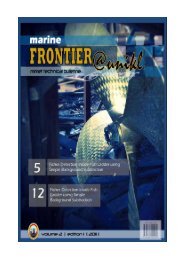click here to download - UniKL MIMET Official Website
click here to download - UniKL MIMET Official Website
click here to download - UniKL MIMET Official Website
You also want an ePaper? Increase the reach of your titles
YUMPU automatically turns print PDFs into web optimized ePapers that Google loves.
Figure 2.3 Illustration of Future Expansion in Coastal Water<br />
(Kaalstad, 2006).<br />
Traditionally, the regulation of maritime<br />
transport operations by seafaring countries has<br />
been motivated by the desire <strong>to</strong> establish and<br />
maintain:<br />
�� Standards as regards maritime safety and<br />
the protection of the marine environment;<br />
�� Participation of national fleets in the trans‐<br />
port of its trade (although by and large in the<br />
OECD t<strong>here</strong> exists unrestricted market ac‐<br />
cess);<br />
�� Commercial regulations aimed at facilitat‐<br />
ing the orderly conduct of business; and<br />
�� The ability of sea carriers <strong>to</strong> operate tradi‐<br />
tional co‐operative liner services despite<br />
the presence of laws in many countries<br />
aimed at preventing anti‐competitive be‐<br />
haviors.<br />
As mentioned by Luketa, A. et al (2008); such,<br />
the risk mitigation and risk management ap‐<br />
proaches suggested in the 2004 report are still<br />
appropriate for use with the larger capacity<br />
ships. Proactive risk management approaches<br />
can reduce both the potential and the hazards<br />
of such events. The approaches could include:<br />
<strong>MIMET</strong> Technical Bulletin Volume 1 (2) 2010<br />
�� Improvements in ship and termi‐<br />
nal safety/security systems,<br />
�� Modifications <strong>to</strong> improve effec‐<br />
tiveness of LNG tanker escorts, vessel<br />
movement control zones, and safety<br />
operations near ports and terminals,<br />
�� Improved surveillance and<br />
searches, and<br />
�� Improved emergency response<br />
coordination and communications<br />
with first responders and public<br />
safety officials.<br />
In this particular project research, the quanti‐<br />
tative survey technique is being applied. The<br />
result from the quantitative input, will be<br />
tested through descriptive statistic and the<br />
interference statistic. The descriptive statistic<br />
will interrogate the sample characteristic and<br />
the interference will drill in<strong>to</strong> sample popula‐<br />
tion.<br />
Results on Carrier Aspect – Operational Proce‐<br />
dure<br />
Table 3.1 shows the analysis on the sur‐<br />
vey data obtained from the block of question‐<br />
naires aimed at confirming ‘Operational Proce‐<br />
dure’ as an element of the legal framework. The<br />
table shows an overall mean of 4.0683 and an<br />
overall standard deviation of 0.3869. Question<br />
1, 2, 8, 9 and 10 return with individual means<br />
above 4.0. Question 10 “LNG ships handling<br />
procedures while in harbour and restricted ba‐<br />
sin are more stringent” scores the highest mean<br />
4.526 with standard deviation of 0.647. The rest<br />
of the questions (question 3, 4, 5, & 7) return<br />
with individual means lower than 4.0. Question<br />
6 “Coastal LNG ships require more crew than<br />
deep sea LNG ships” returns with the lowest<br />
mean of 3.368 and with standard deviation of<br />
1.207.<br />
| MARINE FRONTIER @ <strong>UniKL</strong><br />
78



